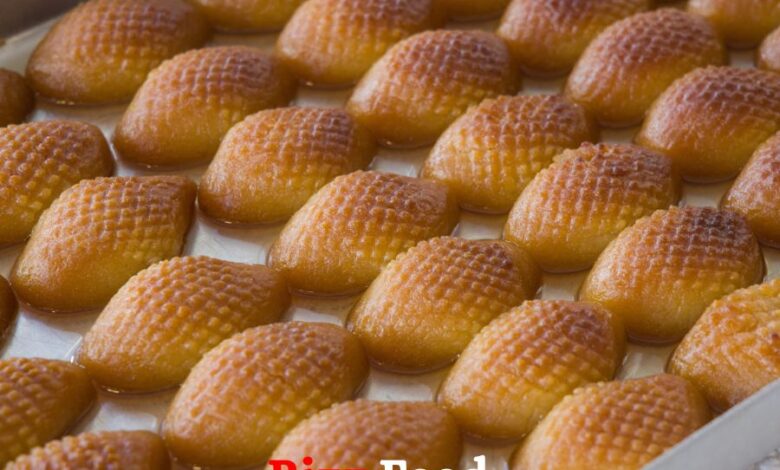What Is Ğuf? A Guide to the Turkish Dessert

If you’re a fan of Turkish cuisine, you’ve likely come across the delightful dessert ğuf. This traditional pastry has been enjoyed in Turkey for centuries and continues to captivate dessert lovers with its unique flavors and textures. In this comprehensive guide, we’ll delve into the world, its origins, ingredients, preparation methods, serving options, health benefits, and more. Whether you’re a seasoned ğuf lover or new to this delectable treat, this guide will provide you with all the information you need to appreciate and enjoy.
Origins and Meaning of Ğuf
A traditional Turkish pastry, is a beloved delicacy known for its delicate layers of dough and flavorful fillings. The name ğuf is derived from the Turkish word “göbete,” which means to fold. This name perfectly captures the essence of ğuf, as it is created by layering and folding the dough to develop its distinctive texture.
Unique Texture and Flavors
What sets ğuf apart from other pastries is its unique texture. With a flaky exterior and a soft, chewy interior, each bite is a delightful experience for your taste buds. The fillings of ğuf can be both sweet and savory, offering a wide range of flavors to suit different preferences. Whether it’s a combination of nuts, dried fruits, and honey or a tasty blend of cheese, spinach, and meat, Offers a diverse palate of flavors to satisfy any craving.
The History of Ğuf
Ottoman Empire and Sultan Abdul Hamid II
The origins of ğuf can be traced back to the Ottoman Empire, particularly during the reign of Sultan Abdul Hamid II. Legend has it that a palace chef accidentally invented the pastry while attempting to create a new dessert for the sultan. The name “Ğuf” is believed to have originated from the Arabic word “ghuff,” which means foam or froth, referencing the pastry’s airy and layered structure.
Evolution and Spread of Ğuf
Puickly gained popularity throughout Turkey and became a staple at weddings and other festivals. Over time, the dish spread to neighboring countries such as Greece and Bulgaria, where it continues to be enjoyed today. While traditional ğuf recipes feature sweet fillings like pistachios or walnuts mixed with honey or sugar syrup, savory variations with ingredients like feta cheese, spinach, or minced meat have also emerged.
Ingredients and Preparation
The critical ingredients for making ğuf include semolina flour, yogurt, butter, eggs, and various fillings. Semolina flour gives the dough a distinct texture, while yogurt and butter contribute to its richness and flavor. Eggs bind the dough together, and the fillings can range from nuts and dried fruits to savory options like cheese, spinach, or minced meat.
Techniques for Dough Preparation
Preparing the dough for ğuf requires kneading the ingredients together until a smooth and elastic consistency is achieved. The dough is then allowed to rest for some time to develop its desired texture. After resting, the dough is rolled out into thin sheets and cut into squares or circles, ready to be filled and folded.
Filling Options for Ğuf
Offers a wide range of filling options, depending on personal preferences and regional variations. Sweet fillings often include nuts such as pistachios or walnuts mixed with honey or sugar syrup for a delectable sweetness. Savory fillings can feature ingredients like feta cheese, spinach, minced meat, or even potatoes, providing a delicious and satisfying flavor profile.
Varieties of Ğuf
Sweet ğuf variations are a popular choice for dessert lovers. These versions often feature a combination of nuts, dried fruits, and honey or sugar syrup. The filling is layered between the delicate dough, creating a sweet and satisfying treat. Some regional variations may incorporate spices like cinnamon or cloves for added flavor complexity.
Savory Ğuf Variations
Savory ğuf variations offer a delightful twist on the traditional sweet pastry. These versions often contain cheese, spinach, minced meat, or potatoes. The delicious fillings provide a rich and spicy flavor profile, making them perfect for appetizers or tasty snacks.
Traditional Turkish Breakfast
It is often enjoyed as part of a traditional Turkish breakfast. It can be served alongside freshly made syrup or honey, offering a delightful combination of sweet and savory flavors. The flaky layers of ğuf provide a satisfying texture, while the fillings add flavor to the meal.
Creative Dessert Ideas
Can be incorporated into various creative dessert ideas. One popular option is to create an ice cream sundae by topping a scoop of ğuf with fresh fruits and a drizzle of honey or chocolate sauce. Another idea is to layer ğuf with yogurt, nuts, and raisins to create a delicious parfait-like dessert. The versatility of ğuf allows for endless possibilities when making unique and delicious desserts.
Ğuf in Other Dishes
Also be used as an ingredient in other dishes. For example, it can be incorporated into pancakes or omelets for a savory twist on a classic dessert. The flaky layers of ğuf add a unique texture and flavor to these dishes, making them a delightful treat for any mealtime.
Health Benefits of Ğuf
Offers several nutritional benefits, depending on the ingredients used. Depending on the filling and preparation method, it can provide a good source of protein, fiber, vitamins, and minerals. Nuts and dried fruits used in sweet variations are rich in antioxidants and healthy fats, while savory fillings like spinach can provide essential vitamins and minerals.
High-Fiber Content and Digestive Health
High-fiber content can contribute to good digestive health. Fiber helps regulate bowel movements, promotes satiety, and supports overall gut health. Using whole grain or semolina flour dough adds to its fiber content, making it a more nutritious choice than other pastries.
Potential Antioxidant Benefits
With nut-based fillings, such as pistachios or walnuts, offers potential antioxidant benefits. These nuts are rich in antioxidants, which help protect the body against harmful free radicals and reduce the risk of chronic diseases. Antioxidants can also support heart health and boost the immune system.
Finding Ğuf in Turkey and Abroad
Turkey is the best place to find authentic ğuf. It can be found in various regions, and each area may have unique twists and flavors. Local cafes, restaurants, and bakeries are the perfect places to experience the true essence of ğuf. Cities like Istanbul, Izmir, and Ankara are known for their diverse culinary scenes and are great destinations to explore the different variations.
Global Ğuf Appreciation
In recent years, Gained popularity beyond Turkey’s borders. Turkish restaurants and food establishments worldwide have started incorporating ğuf into their menus, allowing people from different cultures to experience this delightful pastry. The versatility and unique flavors of ğuf have made it a beloved dessert choice among dessert enthusiasts worldwide.
Making Ğuf at Home
Step-by-Step Guide to Homemade
Making ğuf at home can be a rewarding culinary experience. Here’s a step-by-step guide to help you create your batch of delicious:
- Prepare the dough by combining semolina flour, yogurt, butter, eggs, and a pinch of salt. Knead the dough until it becomes smooth and elastic.
- Let the dough rest for about 30 minutes, covered with a damp towel to allow it to relax and develop its texture.
- Roll the dough into thin sheets using a rolling pin or pasta machine. Cut the sheets into squares or circles using cookie cutters or other tools.
- Place the desired filling, such as a nut and honey mixture or a savory cheese and spinach blend, onto each square or circle of dough.
- Fold each piece of dough over to enclose the filling, pressing down firmly to seal the edges.
- Preheat the oven to 350°F (180°C) and line a baking sheet with parchment paper.
- Place on the baking sheet and brush them with beaten egg yolk for a golden color.
- Bake for approximately 15-20 minutes or until the lightly golden brown.
- Remove from the oven and transfer to a serving tray.
- Serve the hot and enjoy!
Tips for Perfecting Your Ğuf
To ensure a perfect batch, consider the following tips:
- Use fresh and high-quality ingredients to enhance the flavors.
- Properly knead the dough to achieve the desired texture.
- Let the dough rest adequately to allow for easier rolling and folding.
- Experiment with different fillings to discover your favorite flavor combinations.
- Brush with beaten egg yolk before baking for a beautiful golden color.
- Monitor the baking time carefully to prevent overbaking and maintain the desired texture.
Classic Ğuf Recipe
Ingredients:
- Semolina flour
- Yogurt
- Butter
- Eggs
- Walnuts or pistachios
- Honey or sugar syrup
Prepare the dough by combining semolina flour, yogurt, melted butter, and eggs. Knead until smooth and elastic.
- Let the dough rest for 30 minutes, covered with a damp towel.
- Roll the dough into thin sheets and cut into squares or circles.
- Place a mixture of crushed walnuts or pistachios and honey or sugar syrup onto each piece of dough.
- Fold the dough over the filling and seal the edges.
- Bake in a preheated oven at 350°F (180°C) for 15-20 minutes or until golden brown.
- Serve with a drizzle of honey or sugar syrup.
Variations and Creative Twists
Feel free to experiment with different fillings and flavors. Here are a few creative ideas:
- Sweet Variations:
- Nutella and banana filling
- Dried fruits and honey
- Chocolate and hazelnut spread
- Savory Variations:
- Feta cheese and spinach filling
- Minced meat and vegetable filling
- Potato and herb filling
Let your imagination run wild and create unique variations using your favorite ingredients and flavors.
Conclusion
A delightful Turkish pastry with a unique blend of flavors and textures. With its delicate layers of dough and various sweet and savory fillings, ğuf has become a beloved dessert and snack option in Turkey and beyond. Whether you enjoy it as part of a traditional Turkish breakfast or get creative with dessert ideas, It will satisfy your cravings. Following the step-by-step guide and tips, you can even try making your own ğuf at home. So, embark on a culinary adventure and discover the wonders yourself.
You Must Read: BBC Good Food UK


